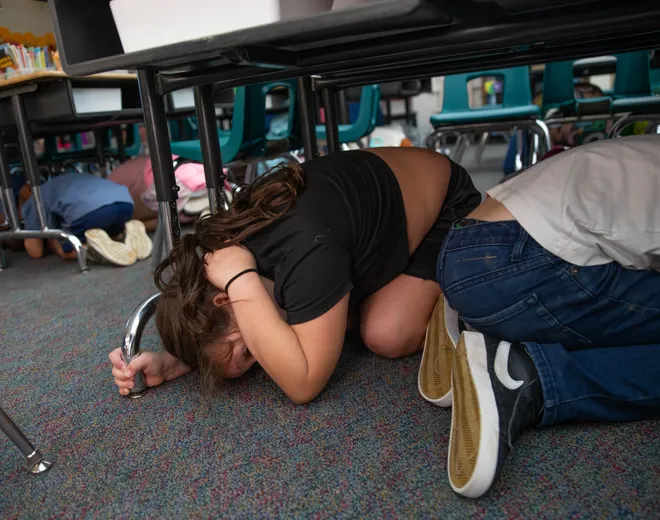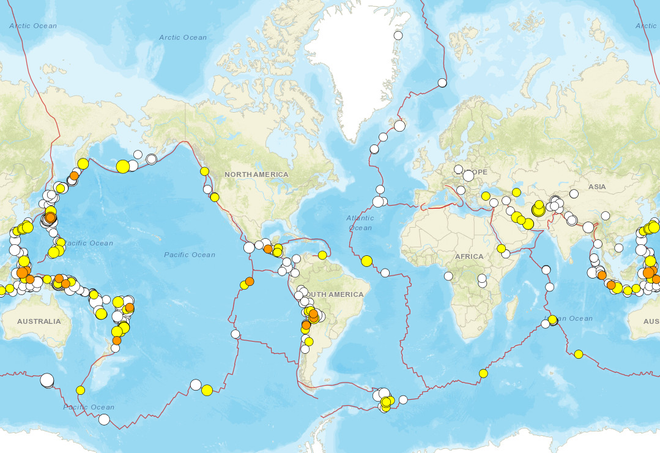Are earthquakes happening more? What to know if you're worried and how to stay safe.
More than 19 million Americans joined an international earthquake drill on Thursday that encouraged people to drop, cover and hold on, a planned event that happened just a day after a quake rattled northern California.
But millions more are at risk, said Mark Benthien, global ShakeOut coordinator and outreach director for the Southern California Earthquake Center at the University of Southern California.
The chances of an earthquake somewhere around the world are 100% every day, Benthien said.
The Earth often shakes the ground across the nation and its territories. Hillsborough, North Carolina felt an earthquake on Thursday, according to the U.S. Geological Survey.
That North Carolina quake was one of more than 150 earthquakes of at least a 2.0 magnitude across the continental United States in 19 states over the past week. At least 34 earthquakes of a 2.5 magnitude or higher occurred in Puerto Rico, 30 in Alaska and 10 in Hawaii in the last seven days.

Should you worry about an earthquake?
No. Should you prepare? Absolutely. Earthquakes can occur anywhere in the country, although they are less frequent in some places.
“People need to know and practice what to do,” said Benthien.
"We're trying to get people to be more self-sufficient, because in a big earthquake there’s not going to be help from the neighboring city," he said. “They’re going to be impacted too.”
And when a big one occurs, it’s likely to trigger others around it.
Are there more earthquakes than there used to be?
It may seem like it, but that's because we’ve seen dramatic improvement in the quantity and quality of equipment that records seismic activity in the Earth, Benthien said. We “have the ability to record smaller and smaller earthquakes,” not just in California, but in distant locations where there aren’t any people, and even under the seafloor.
In some respects, we owe improvements in earthquake forecasting to the Cold War, Benthien said. Seismometers were established in far-flung locations across the world as the U.S., Russia and China tried to monitor whether the others were conducting underground nuclear tests. As a college student, he once worked along a fault in Siberia and Mongolia.
Apps alert phones when shaking is detected and social media also has contributed to the more frequent communication of earthquakes. “People are feeling small earthquakes and posting about it,” he said. “So it seems like there’s a lot more earthquakes happening, but it’s because there’s a lot more earthquake information happening and happening more frequently.”
It’s normal for seismic activity to temporarily increase or decrease, and neither positively indicates a large earthquake is eminent, according to the geological survey.
The earthquake risk is growing, because of increasing human and economic exposure and the number of assets being built in high earthquake hazard areas, the Federal Emergency Management Agency said in a report earlier this year.
Although Alaska is the most seismically active state in the U.S., the risks and potential impacts are greater in California because it has the highest estimated potential loss due to earthquakes, according to the geological survey.

Why do earthquakes occur?
The Earth’s crust is like the shell of an egg. It’s very thin compared to the planet. Like the shell of a hard-boiled egg breaks into pieces when you crack it, the earth’s crust is broken into large pieces or plates and those plates move around, Benthien said.
The Pacific plate moves to the northwest at a speed of 3-4 inches a year, while the North American plate moves to the west-southwest at about an inch a year, according to the Pacific Northwest Seismic Network. The motion of the plates around the globe is the primary source of strain that leads to earthquakes.

Is that earthquake part of a cluster or swarm? Is it a foreshock or an aftershock?
Major quakes are often preceded by smaller quakes, foreshocks, and followed by additional quakes, aftershocks, which can also be quite large.
Earthquakes often occur in groups of mostly small earthquakes with no identifiable mainshock, according to the geological survey. These groups are called clusters or swarms, terms sometimes used interchangeably, said Steven Sobieszczyk, a spokesman for the geological survey.
A group of researchers at the University of Utah are studying the swarms of earthquakes that occur there. Many of the frequent earthquakes in the region are small, happening imperceptibly, but in surges, clustered in time and space, researchers Gesa Petersen and Kristine Pankow stated in a study published in July.
The “seismic groups” strike a region over a short period of time and dozens have been recorded in Central Utah over 40 years. As many as 30, 40 or 50 events occur over a few hours and then it pauses. That occurs repeatedly, the researchers said.
Of all the sequences of seismic activity in the region, 80% are swarms, the researchers said. The university’s seismologists are analyzing that data to try to determine their significance.
Is advanced warning for earthquakes improving?
That depends. In the way that people would like to know — a day or a week in advance? No, Benthien said.
But the probability of a significant earthquake in a specific area within a number of years can be calculated.
For example, seismologists say it's likely the San Andreas will one day have a big earthquake, Benthien said.
The chances of knowing in advance where an earthquake might occur in relation to an earthquake that just occurred, are increasing, Benthien said. For example, they know there will be aftershocks after big earthquakes, he said. “When an earthquake happens, the best we can do is say, there’s a 100% chance there’s going to be aftershocks. There’s a 5% chance that it could be even bigger.”
The Statewide California Earthquake Center recently received a grant to establish a science "gateway" to improve analysis of rupture forecasts, which could provide information about the likelihood of having earthquakes of different sizes at different locations, and simulate the coupled evolution of earthquakes and faults for the first time.
How realistic is the possibility of having an earthquake over a 9.0 magnitude?
That depends where you live, Benthien said. An earthquake can only be as big as the fault line where it occurs, so you have to have a large, long fault to have a large earthquake.
For example, in the 2015 movie “San Andreas,” with Dwayne “The Rock” Johnson, a 9.1 magnitude earthquake in Los Angeles triggered a 9.6 magnitude earthquake in San Francisco. It can't happen, Benthien said. The fault isn't big enough.
It would be unlikely for Southern California to have an earthquake of greater than 8.3 magnitude, the USGS said. They’ve had an earthquake as large as a 7.9 magnitude earthquake in the past.
A 9.0 or larger earthquake would only occur along a subduction zone, Benthien said. Those occur chiefly in coastal regions where an oceanic plate in the earth’s crust meets a continental plate along a tectonic plate boundary and slides beneath it.
One subduction zone occurs in Alaska, where a 9.2 earthquake shook the Prince William Sound region in 1964. It remains the most powerful on record in North America. The quake and the resulting tsunami killed 131 people. A peak wave height of roughly 219 feet occurred at Valdez Inlet and waves were detected on tide gages as far away as Cuba and Puerto Rico.
Subduction zones occur around the Pacific, in an area sometimes called the "Ring of Fire" for its earthquakes and volcanic eruptions. It includes the Pacific Northwest, the area of the U.S. at greatest risk, and the west coast of South America, where the largest recorded earthquake in the world – 9.5 – occurred in Chile on May 22, 1960.
What should you do during an earthquake?
Actual shaking rarely causes injury. Injuries and death occur when walls and roofs collapse and glass and other objects fly or fall, especially when people try to move during the shaking, according to Shake Out. No matter where you are, don't move if you can avoid it until you're sure it's safe.
When the shaking starts, ShakeOut advises the following:
- If you are inside a building, move no more than a few steps, drop to the ground, take cover by getting under a sturdy desk or table and hold on to it until the shaking stops.
- If outdoors, find a clear spot away from buildings, trees, streetlights, and power lines, then drop, cover and hold on and stay until the shaking stops.
- If driving, pull over to a clear location, stop and keep your seatbelt fastened. Once the shaking stops, proceed with caution, avoiding damage that might have occurred.
Disclaimer: The copyright of this article belongs to the original author. Reposting this article is solely for the purpose of information dissemination and does not constitute any investment advice. If there is any infringement, please contact us immediately. We will make corrections or deletions as necessary. Thank you.




